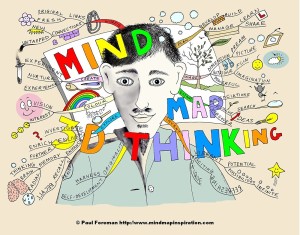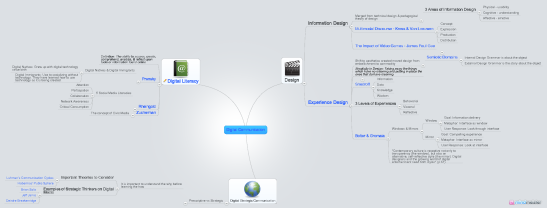Strategic versus Prescriptive Communication – YES Digital Needs Both

Image Courtesy of Paul Foreman via http://www.mindmapinspiration.com
Understanding why you should do something is critical to the process of learning how to do something. In order to responsibly and critically use communication tools an individual must first have a strong foundation for why this type of communication is important in the first place. This foundation is large reason why I went back for my MA in Strategic Communication.
Sadly, there appears to be a disconnect between understanding communication theory and relevance and digital media users. Peruse any digital bookstore and you will see thousands of titles on how to blog, Twitter for Dummies and grow your business by using Facebook. However, what is lacking among the enthusiasm to use digital communication tools is the simple question of whether or not they should be used and if so why.
I recently read Jeff Jarvis’s Public Parts. The book was excellent on many levels and it did a superb job of providing detailed information on both the theoretical and practical side of digital communication. Instead of seeing a forest and focusing on a tree, Jarvis choose to discuss a species within the forest of digital communication; the idea of public versus private information. This is an important topic as governments and people determine ethical and legal ways to manipulate the internet for profit and commoditization. If more people would approach the subject of digital communication by looking at it from a fifty thousand foot view then perhaps we could answer questions about how to better prepare our communities, children and even ourselves to communicate in this new and exciting space.
With these thoughts in mind, I set out to create a digital media experiment that combined several important theories using new online communication software that wrapped the why and the how together in a simplistic design and format.
There are lots of communication theories and all of them have their validity and purpose. However, as I have studied theories on strategic communication, digital literacy, information and experience design there have been three that stood out and noticeably shaped the way I view strategic digital communication. They include:
- Habermas’ Public Sphere: The idea that an elite group, usually comprised of the bourgeois (or the upper middle class), comes together by gathering consensus through intelligent discussions of the public good.
- Bolter & Gromala’s Windows & Mirrors: Is the idea that design is both transparent (like a window) and reflective (like a mirror).
- Shedroff’s Information & Experience Design Continuum: Data is organized into information which is presented to create knowledge and reflected upon to create wisdom.
With these theories in mind, I researched several different tools online and found a wonderful resource called LearningThroughDigitalMedia.net. They have a very comprehensive toolkit with a variety of different online software products categorized. To access their toolkit click here. Using the toolkit, I found Mindmeister.com. Mindmeister is a mind mapping software that allows you to map ideas and collaborate with colleagues. Eureka! What better way to culminate my digital media experiments then by creating one that interactively outlines all of the important information I have learned about digital communication.
Using Mindmeister I can create an interactive public learning environment that allows information to be shared with anyone who has an internet connection and an account. In doing so more people have access to and can disseminate the information furthering the internet revolution’s main achievement in communication; the deconstruction of Habermas’ elite and the rise of the proletariat public sphere.
Additionally, using Mindmeister allows the information to serve as both a window and a mirror. Anyone can view and peruse the mind map getting lost in the information or they can reflect and use the tool to add their own perspective.
Finally, using Mindmeister allowed data to be culled into information and knowledge. By using a tool that allowed collaboration, as a class we can generate wisdom by reflecting and sharing all of our knowledge with each other; thus creating a more comprehensive communication piece.
For a PDF of the strategic digital communication mind map click here
Digital_Communication Experiment 3
References:
Bolter, J. D. & Gromala, D. (2003). Windows & Mirrors: Interaction Design, Digital Art and the Myth of Transparency. The MIT Press. Cambridge, MA.
Habermas, Jürgen (German(1962)English Translation 1989), The Structural Transformation of the Public Sphere: An Inquiry into a Category of Bourgeois Society, Thomas Burger, Cambridge Massachusetts: The MIT Press, p. 30, ISBN 0-262-58108-6
Shedroff, N. (2009). Experience Design 1.1. Experience Design Books

